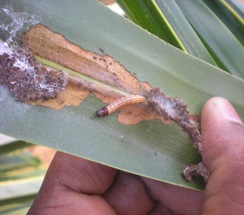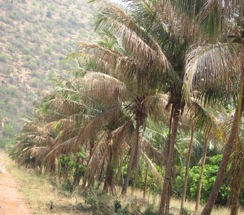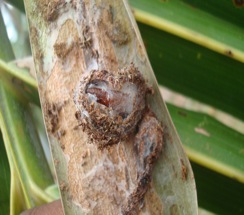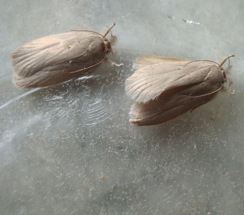Leaf Eating Caterpillar/ Black Headed Caterpillar: Opisina arenosella
This causes severe damage to palms in coastal and back water areas and in certain internal packets of peninsular in India. The pest occurs round the year with the spike in population during summer (Mar-May).
Symptoms of Damage:
- The coconut trees of all ages are attacked.
- Dried up patches on leaflets of the lower leaves, only three or four youngest leaves at the center of the grown remain green.
- Galleries of silk and frass on under side of leaflets.
- In case of severe infestation the whole plantations present a scorched appearance.
 |
 |
 |
Dried up patches
|
Galleries of silk |
Scorched appearance |
Identification of the Pest:
- Larva: Caterpillar is greenish brown with dark brown head and prothorax, and a reddish mesothorax. It has brown stripes on the body.
- Pupa: It pupates inside the web itself in a thin silken cocoon
- Adult Moth: Greyish white in colour
- Female: with long antenna and three faint spots on the forewings
- Male: with fringed hairs in hind wings in apical and anal margin.
Management:
Cultural Method:
- As a prophylactic measure, the first affected leaves may be cut and burnt during the beginning of the summer season.
Biological Method:
- Among the larval parasitoids, the Bethylid, Goniozus nephantidis, (Elasmus nephantidis (brown species) and Brachymeria nosatoi – KAU) is the most effective in controlling the pest. The optimum level of release is 1:8 of host-parasitoid ratio. The parasitoid should be released @ 3000/ha under the coconut trees when the pest is in the 2nd or 3rd instar larval stage. Parasitoid release trap may be used to release the parasitoid at the site of feeding. Parasitoids should not be released in the crown region since they will be killed by predators like spiders and reduviid bugs. This should be released only three weeks after chemical spray.
- Release the larval (Bethylid, Braconid and Ichneumonid) and pupal (Eulophid) on (chalcid) parasitoids and predators periodically from January, to check the build up of the pest during summer.






